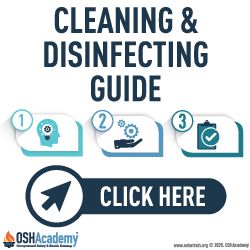Cleaning and Disinfecting Procedures
Cleaning and disinfecting public spaces, including your workplace, school, or business, will require a three-step plan:
- develop your plan
- implement your plan
- maintain and revise your plan
Reducing the risk of exposure to illnesses through cleaning and disinfection is an important part of reopening public spaces and will require careful planning. Everyone has been called upon to slow the spread of infectious diseases, such as COVID-19, through social distancing and preventive hygiene, including frequent hand washing and wearing face coverings. Below is a summary of the increased risks workers faced during the COVID-19 pandemic.
Increased Chemical Exposure: The rise in disinfectant use led to higher incidents of exposure to cleaning chemicals, resulting in respiratory issues, skin irritation, and toxic inhalation cases. Poison control centers reported a significant increase in calls related to disinfectant exposure early in the pandemic, highlighting the importance of proper ventilation, PPE use, and training in handling cleaning agents safely (CDC and CCOHS).
Workplace Injury and Illness Data: According to the U.S. Bureau of Labor Statistics, workplace injuries and illnesses spiked, including those linked to COVID-19 infections in work settings where employees were at higher risk due to proximity to potentially contaminated surfaces and increased use of cleaning agents. Non-fatal work-related illnesses, including respiratory and skin-related conditions, saw marked increases in these roles (BLS).
The EPA has compiled a list of disinfectant products that can be used against viruses, including COVID-19. The list includes ready-to-use sprays, concentrates, and wipes.
This course provides a general framework for cleaning and disinfection practices. The framework is based on doing the following:
- Routine Cleaning
- Normal routine cleaning with soap and water will decrease how much of the virus is on surfaces and objects, which reduces the risk of exposure.
- Disinfecting
- Disinfection using EPA-approved disinfectants against COVID-19 can also help reduce the risk. Frequent disinfection of surfaces and objects touched by multiple people is important.
- Alternative Disinfectants
- When EPA-approved disinfectants are not available, alternative disinfectants can be used (for example, 1/3 cup of bleach added to 1 gallon of water, or 70% alcohol solutions). Do not mix bleach or other cleaning and disinfection products together—this can cause fumes that may be very dangerous to breathe in. Bleach solutions will be effective for disinfection up to 24 hours. Keep all disinfectants out of the reach of children. Always take safety precautions and wear proper personal protective equipment (PPE) when using disinfectants.
Knowledge Check Choose the best answer for the question.
1-1. Bleach solutions will be effective for disinfection against bacteria and viruses for up to _____.
You forgot to answer the question!


